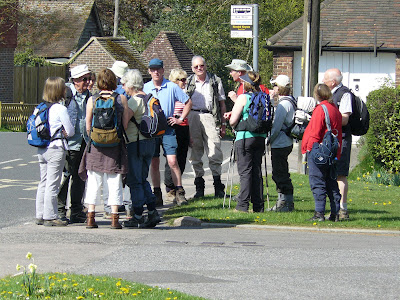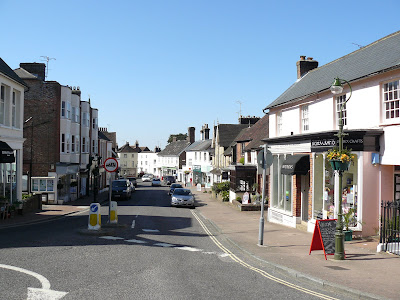Three days ago, on the blog entry below, I searched under every hazel bush for 9 miles on the Sussex Border Path looking for Toothwort -- all to no avail.
Today we found it in The Long Plantation at grid reference TQ 146/ 268563 to 268564. It is about 35 minutes walk from Kingswood Train Station in case you want to see it.
In the foreground are the Toothwort flowers conveniently growing right next to the public footpath.
In Yorkshire this plant was known as Corpse flower.
The plant is parasitic on Hazel, spent catkins of which can be seen above for size comparison.
The flowers have protruding stigmas, which were doubtless fertilised by this bubble bee which sampled each flower in turn.
For pictures from last year click here
There is another Toothwort species to be seen near the Loder Valley Nature Reserve. Click here for pictures of that one, which we should find on a Mid Sussex Ramblers' walk later this month.
For illustrated talks on natural history and history see www.peterlovetttalks.co.uk
For illustrated talks on natural history and history click here for www.peterlovetttalks.co.uk
Friday, 30 April 2010
Wednesday, 28 April 2010
Early Purple Orchids
This was a linear walk from the Mid Sussex Ramblers' programme, lead yesterday by Mike and starting with a bus from Horstead Keynes to East Grinstead.
The medieval houses in East Grinstead High Street are believed to form the longest continuous row of such buildings in the country.
We followed Forest Way, a disused railway line, along the Sussex Border path....
...which heads off to Weir Wood reservoir.
Approaching Weir Wood reservoir, we entered a field after Horseshoe Farm where there were many orchids in the woodland edge. Click on any picture to expand it.
David Lang states in "Wild Orchids of Sussex" that "Early-purple orchids can remain in a vegetative state for years, flowering when woodland is cleared and the light increases." This would appear to be the case at this site.
I tried to smell one through the fence but could not detect the various scents reported.
It was good to get a view of Highbrook church from a northerly direction, which was a new sight for me.
The border path crosses typical High Weald ghylls, meadows and woods that have remained unchanged for centuries.
Broadhurst Manor on the approach to Horstead Keynes.
Many thanks Mike for a great walk.
The medieval houses in East Grinstead High Street are believed to form the longest continuous row of such buildings in the country.
We followed Forest Way, a disused railway line, along the Sussex Border path....
...which heads off to Weir Wood reservoir.
Approaching Weir Wood reservoir, we entered a field after Horseshoe Farm where there were many orchids in the woodland edge. Click on any picture to expand it.
David Lang states in "Wild Orchids of Sussex" that "Early-purple orchids can remain in a vegetative state for years, flowering when woodland is cleared and the light increases." This would appear to be the case at this site.
I tried to smell one through the fence but could not detect the various scents reported.
It was good to get a view of Highbrook church from a northerly direction, which was a new sight for me.
The border path crosses typical High Weald ghylls, meadows and woods that have remained unchanged for centuries.
Broadhurst Manor on the approach to Horstead Keynes.
Many thanks Mike for a great walk.
Tuesday, 27 April 2010
Where have all the tadpoles gone?
Some horrible disease of frogs has removed breeding frogs from my garden for a couple of years. Now imported tadpoles from Surrey have mysteriously disappeared from my ponds and the newts are fewer in number. The answer is possibly below.
Click on any picture to expand it.
What looked like a blob of excrement moved off! It went too quickly to get a closer picture.
It is a grass snake, which eats tadpoles, frogs and newts, insects and perhaps slugs. It is in turn eaten by foxes and badgers, both of which frequent my garden. The balance of nature should check the growth of the grass snake population, but I fear that it is too late for the tadpoles and frogs, if any.
Click on any picture to expand it.
What looked like a blob of excrement moved off! It went too quickly to get a closer picture.
It is a grass snake, which eats tadpoles, frogs and newts, insects and perhaps slugs. It is in turn eaten by foxes and badgers, both of which frequent my garden. The balance of nature should check the growth of the grass snake population, but I fear that it is too late for the tadpoles and frogs, if any.
Friday, 23 April 2010
Cuckfield Historical Circular walk, 10.7 miles.
In defining this walk, I was inspired by "A Chronicle of Cuckfield" by Maisie Wright, available from Cuckfield Museum (details at www.cuckfield.org).
The earliest known reference to Cuckfield Grammar School is the will of Edmund Flower dated 1521. The Old Grammar School building above bears the date 1632.
Cuckfield High Street. Some buildings in Cuckfield date from the 14th century.
If you are interested in a lead walk in and around Cuckfield or in the wider Sussex area please click www.peterlovettwalks.eu Postcards of Cuckfield are available in the Post Office in the High Street.
The High Weald Landscape Trail towards Lower Spark's Farm.
It was a joy to spot this bee fly feeding on the primroses. Click on this and any other picture to expand it.
The view towards the White House, zoomed below.
The view to Pilstye Farm, dating from the late 15th century. A rick was burnt there by Swing rioters in 1840.
Pheasants are now actively mating. Our pheasants are thought to derive from birds from the Caucasus who were brought by the Greeks to Rome, and by the Romans to Britain. Since then many Chinese pheasants with white collars have been brought here and the two forms have interbred, so most -- but not all -- of our pheasants sport the collar. Ref. Derwent May, The Times, 23 April 2010.
Leaving the track to Sidnye Farm, turn left down Cherry Lane.
Cherry Lane was once part of the London to Brighton stage coach route.
The earliest known reference to Cuckfield Grammar School is the will of Edmund Flower dated 1521. The Old Grammar School building above bears the date 1632.
Cuckfield High Street. Some buildings in Cuckfield date from the 14th century.
If you are interested in a lead walk in and around Cuckfield or in the wider Sussex area please click www.peterlovettwalks.eu Postcards of Cuckfield are available in the Post Office in the High Street.
The beautiful 16th century Manor house, Marshalls.
The High Weald Landscape Trail towards Lower Spark's Farm.
Bee-fly, Bombylius major
You pass Collins Farm.
Sidnye Farm.
Pheasants are now actively mating. Our pheasants are thought to derive from birds from the Caucasus who were brought by the Greeks to Rome, and by the Romans to Britain. Since then many Chinese pheasants with white collars have been brought here and the two forms have interbred, so most -- but not all -- of our pheasants sport the collar. Ref. Derwent May, The Times, 23 April 2010.
Cherry Lane was once part of the London to Brighton stage coach route.
The river Ouse.
Lady's smock growing by the footpath.
Primroses on Cherry Lane.
Wild Cherry flowers.
Greater Stitchwort on the verge approaching Spicer's Farm.
Spicer's Farm, built by the Rev.William Spicer, Rector of Balcombe, the second founder of Cuckfield Grammar School in 1529.
The White House.
The Victory Inn at Staplefield.
There is always a fabulous range of real ales to sample at The Jolly Tanners, and I sank one on this day.
The cricket pitch.
After leaving Staplefield, ignore the footpath on the map, which goes East at a footpath T-junction. A permissive path along the side of the river Ouse is much more interesting.
There used to be a forge downstream from here, the bay (dam) for which was destroyed in 1928.
Cellandines, Lady's Smock, nettles and wild garlic, Ramsons, on the banks of the Ouse. In Covent Garden, I have seen wild garlic leaves on sale at £20/Kg!
View towards Holmsted Manor.
The view northwards from Hammerhill Copse. The history of the High Weald can be read from such evocative place names.
Bigges Farm is from the first half of the 15th century.
Views of Cuckfield on the ridge in the distance with Mizbrook's Farm in the middle distance.
The scene in panoramic view. Click on any picture to expand it.
Looking back westwards towards Toll Shaw....
...and southwards towards the golf course behind the woods.
The footpath crosses the golf course...
...with fine views of the Balcombe viaduct.
If you have enjoyed these pictures and enjoy walking, this is an easy walk to navigate yourself -- assuming map reading skills. Please be aware that there are 300 meters of ascent and descent. You need a good level of fitness to enjoy this walk, which may be too taxing for an unfit walker.
For a shorter, five miles walk from Cuckfield in year 2017 passing through newly planted vineyards, please see https://sussexrambler.blogspot.co.uk/2017/08/cuckfield-vineyards-walk.html
If you prefer to be lead by an experienced walk leader, please see www.peterlovettwalks.eu
Cuckfield itself has a wealth of history. You might enjoy a shorter two miles walk lasting two hours including one hour of explanations around the center of Cuckfield, the Dinosaur memorial and workhouse. Pictures from this walk are available as an illustrated talk. Please see www.peterlovetttalks.co.uk
For a shorter, five miles walk from Cuckfield in year 2017 passing through newly planted vineyards, please see https://sussexrambler.blogspot.co.uk/2017/08/cuckfield-vineyards-walk.html
If you prefer to be lead by an experienced walk leader, please see www.peterlovettwalks.eu
Cuckfield itself has a wealth of history. You might enjoy a shorter two miles walk lasting two hours including one hour of explanations around the center of Cuckfield, the Dinosaur memorial and workhouse. Pictures from this walk are available as an illustrated talk. Please see www.peterlovetttalks.co.uk
Subscribe to:
Comments (Atom)
Blog Archive
-
▼
2010
(88)
-
▼
April
(10)
- Toothwort; a mysterious parasitic plant
- Early Purple Orchids
- Where have all the tadpoles gone?
- Cuckfield Historical Circular walk, 10.7 miles.
- Cowslips on Wolstonbury Hill
- North Downs circular, Sat. 11 April 2010
- A view of Weirwood Reservoir... a beautiful 8 mile...
- You can now search this blog by key words!
- Wood anemones walk from Cuckfield
- Early Dog Violets in Cuckfield graveyard
-
▼
April
(10)






























































